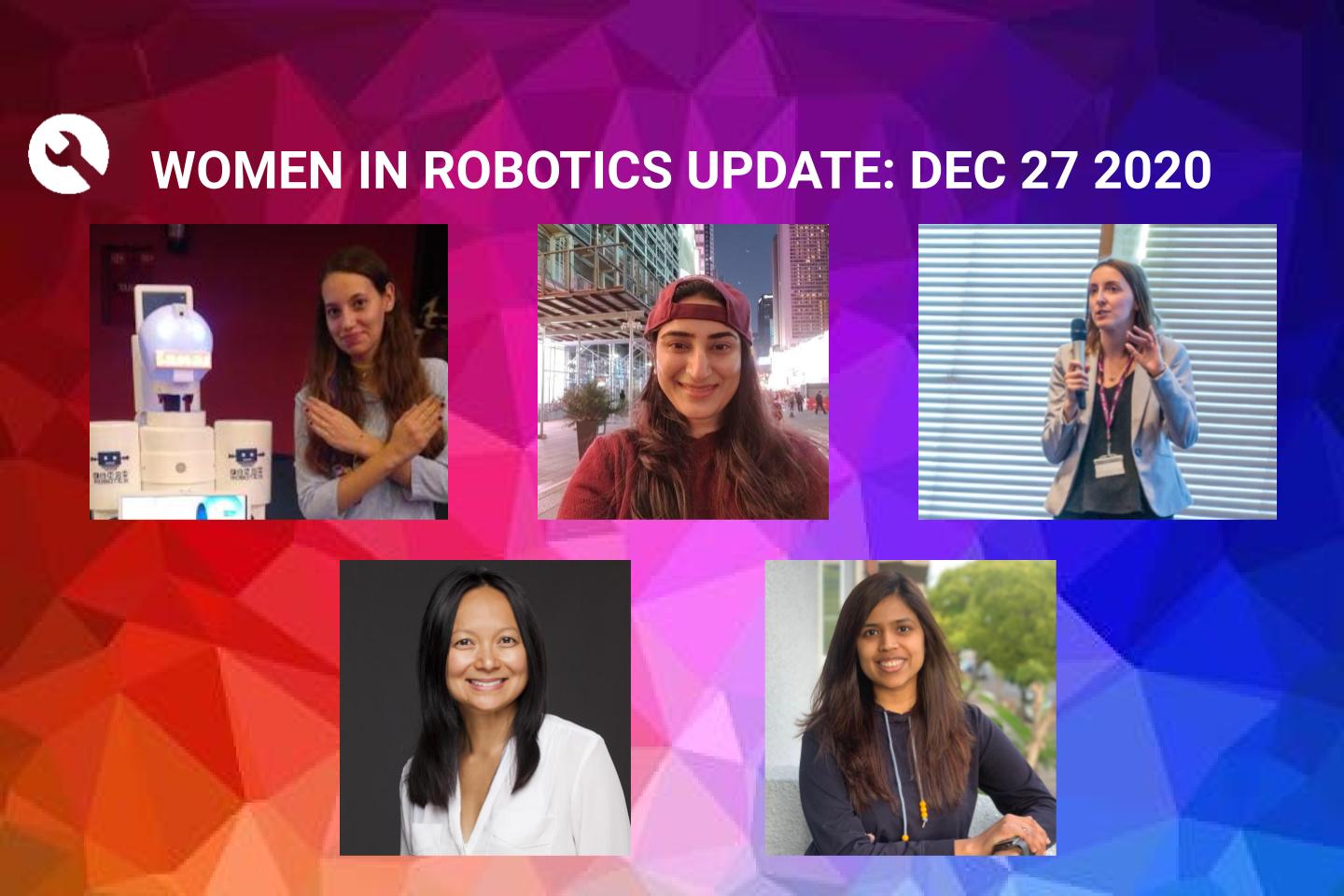Spontaneous robot dances highlight a new kind of order in active matter
Robots with rhythm: Boston Dynamics’ dancing androids a hit
Readers Choice 2020: How Do You Train a Retail Robot?
Happy New Year from Atlas, Spot and Handle
Army research leads to more effective training model for robots
Readers Choice 2020: Smarter Robotics Are Changing Security
Readers Choice 2020: Preparing to be Acquired: COVID-19 Has Inspired Small Manufacturers to Embrace Robotics
Women in Robotics Update: Ecem Tuglan, Tuong Anh Ens, Sravanthi Kanchi, Kajal Gada, Dimitra Gkatzia
Welcome to the first of our Women in Robotics Spotlights, where we share stories from women who haven’t yet been featured in our Annual Showcase but who are working on all sorts of interesting projects. We hope these stories provide inspiration to everyone to join us working in the field of robotics. And if you’re a woman working in robotics, why not contribute your story too!
“Making robots communicate with humans in natural language is a fascinating challenge. There is a lot going on during interactions between robots and humans. Humans make gestures, observe or interact with visible objects in the environment, and display emotions. What motivates me is equipping social robots with the ability to interact seamlessly, by recognizing a given situation and talking about it” says Dimitra Gkatzia who specializes in Natural Language Generation for Human-Robot Interaction.
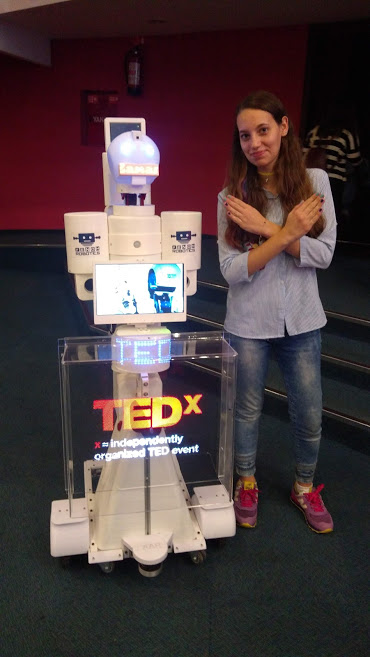 |
Ecem Tuglan
The Mecademi of Team Think Tank | Cofounder of Fenom Robotics
Ecem Tuglan is a The Mecademi of Team Think Tank and Cofounder of Fenom Robotics who is active Robopsychologist working on Philosophy of Artificial Intelligence, Neurophilosophy, Human-Robot interaction, Biopolitics, Robopsychology, Cognitive Sciences and Political Theory. At Fenom Robotics, she and her team builds holograms displaying humanoid robots. She is also working on projects with Dr. Ravi Margasahayam from NASA as a robopsychologist. Tuglan says her interest in robots started during her childhood when she prefered robotic toys and electronic gadgets and this childhood obsession turned more professional when she started studying philosophy. And still, she is always intrigued by how from micro scale to macro scale, everything is changing with robotics and how cell-like robots can save us from various diseases while AI based astrobots can find new home-planets. She enjoys the width of the research in robotics and its interdisciplinary knowledge enhancing our creativity and productivity because we are able to combine anything in our mind to this field. |
 |
Tuong Anh Ens
CEO and Founder at Go West Robotics
Tuong Anh Ens is CEO and founder of Go West Robotics which is a robotics software consulting Company. Exposed to many exciting robotics projects and having very good connections in the robotics community, she decided to focus on helping robotics companies succeed. Her main objective here was to reduce hurdles that occur for so many creative and revolutionizing ideas to take shape and get implemented. Thus, at Go West Robotics, she and her team work with the world’s leading robotics companies to build better automation systems and robots. Ens enjoys the challenges with the future in robotics, ever-changing unknown and our ability to push beyond the boundaries of what was previously inconceivable. Going through the hurdles of both the personal and professional life balance herself, she strongly believes in hardwork and perseverance and believes in her team at Go West Robotics for the accomplishments and growth in robotics. |
 |
Sravanthi Kanchi
Data Engineer at Bayer Crop Science | The Founding Member of The Founders Vault
Sravanthi Kanchi is a data engineer at Bayer Crop Science and the founding member of the Founders Vault. She loves learning, building and researching about building robots and she is currently working to build the home cleaning robot. She enjoys the ideas coming into life in robotics. She aspires to make an impact into people’s lives by building something useful for mankind as she believes in robotics contribution in transformation of healthcare , ergonomics, space, industrial sectors etc. |
 |
Kajal Gada
Content creator at Youtube
Kajal Gada is a robotics software engineer and youtuber. She has 3 years of professional experience. At her last job at Brain Corp, she helped support Brain OS – a software for autonomous mobile vehicles. Her interest in robotics was sparked by a video of drones doing flips autonomously by her mentor who continuously encouraged her to explore robotics. Gada started working on robotics on her own starting with creating her own robot for simple projects such as a line follower and obstacle avoidance and then further enhanced her knowledge in the area with Masters in Robotics from University of Maryland. As the way of giving back to the robotics community she creates and posts tutorials in her youtube channel for free open source software webots to create projects that are beginner friendly, and thus making it easy for anyone to get started with robotics. She has been interviewing existing women in robotics in her youtube channel as well and wants to continue it to inspire younger women and set an example of how someone looking like you started it and did it. |
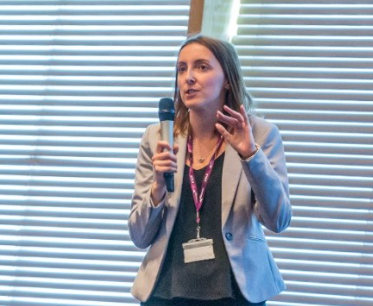 |
Dimitra Gkatzia
Associate Professor at Edinburgh Napier University
Dimitra Gkatzia is an associate professor at School of Computing at Edinburgh Napier University where she leads a UK-funded project in robotics, CiViL. CiViL aims to provide robots with human-like abilities, such as reasoning and communicating using commonsense. She is also a co-founder of the workshop series NLG4HRI, which aims to bring together researchers interested in developing NLG methods for Human-Robot Interaction. Gkatzia’s expertise is in Natural Language Generation (NLG), i.e. teaching computers “how to talk”, Data-to-text generation, AI, Machine Learning, summarization of time-series data. With her proficiency in this field she is dedicated to making dialogue systems (such as Alexa, Siri) converse naturally, by enhancing their responses with commonsense and world knowledge. She entertains the far-ranging scope and the endless possibilities for robotic applications. “Robotics has shown promising results in assistive technology, education, and health”, says Gkatzia who envisions a future where humans and robots coexist and collaborate in domestic, public and work settings and robots used to solve real-world problems. |
And we encourage #womeninrobotics and women who’d like to work in robotics to join our professional network at http://womeninrobotics.org
James Bruton focus series #3: Virtual Reality combat with a real robot
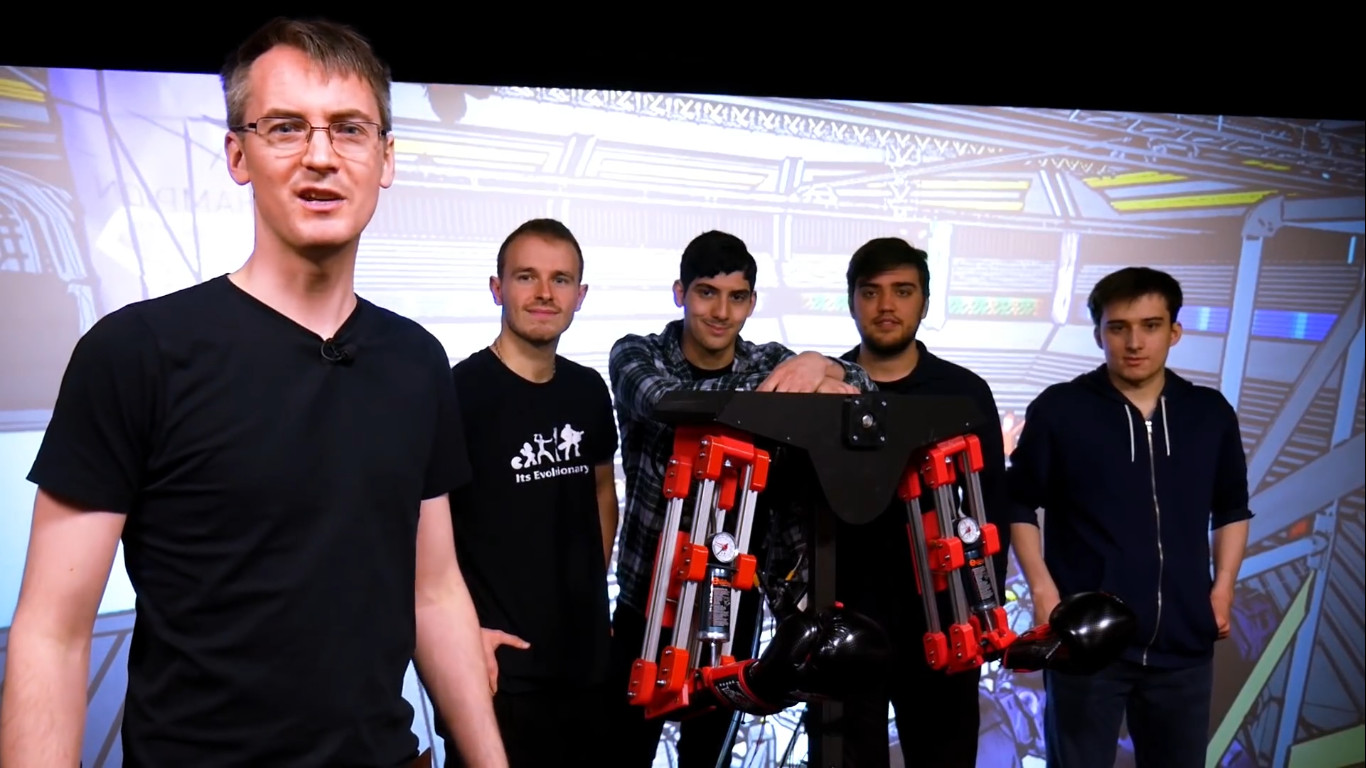
It’s Saturday, it’s the turn of another post of the James Bruton focus series, and it’s Boxing Day in the UK and most of the Commonwealth countries. Even if this holiday has nothing to do with boxing, I didn’t want to miss the opportunity to take it literally and bring you a project in which James teamed up with final year degree students in Computer Games Technology at Portsmouth University to build a robot that fights a human in a Virtual Reality (VR) game.
For this project, the students Michael (Coding & VR Hardware), Stephen (Character Design & Animation), George (Environment Art) and Boyan (Character Design & Animation) designed a VR combat game in which you fight another character. James’ addition was to design a real robot that fights the player, so that when they get hit in the game, they also get hit in real life by the robot. The robot and the player’s costume are tracked using Vive trackers so the VR system knows where to position each of them in the 3D virtual environment. You can see some artwork and more details about the project here and here. Without further ado, here’s James’ video:
Happy holidays!
Holiday robot videos 2020

Thanks to all those that sent us their holiday videos. It’s been a tough year for everyone. We hope these videos make these holidays a bit more special.
Did we miss your video? You can send it to daniel.carrillozapata@robohub.org and we’ll include it in this list.
We wish you the very best for these holidays and the year 2021!
How Transformers work in deep learning and NLP: an intuitive introduction
Readers Choice 2020: How Robots Are Changing On-Site Construction
Embracing automation and robots in industry
Carlotta Berry’s talk – Robotics Education to Robotics Research (with video)
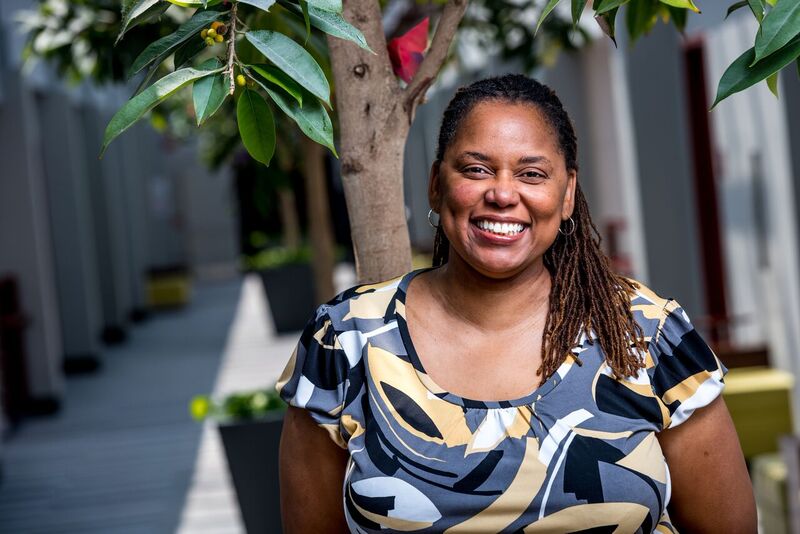
A few days ago, Robotics Today hosted an online seminar with Professor Carlotta Berry from the Rose-Hulman Institute of Technology. In her talk, Carlotta presented the multidisciplinary benefits of robotics in engineering education. In is worth highlighting that Carlotta Berry is one of the 30 women in robotics you need to know about in 2020.
Abstract
This presentation summarizes the multidisciplinary benefits of robotics in engineering education. I will describe how it is used at a primarily undergraduate institution to encourage robotics education and research. There will be a review of how robotics is used in several courses to illustrate engineering design concepts as well as controls, artificial intelligence, human-robot interaction, and software development. This will be a multimedia presentation of student projects in freshman design, mobile robotics, independent research and graduate theses.
Biography
Carlotta A. Berry is a Professor in the Department of Electrical and Computer Engineering at Rose-Hulman Institute of Technology. She has a bachelor’s degree in mathematics from Spelman College, bachelor’s degree in electrical engineering from Georgia Institute of Technology, master’s in electrical engineering from Wayne State University, and PhD from Vanderbilt University. She is one of a team of faculty in ECE, ME and CSSE at Rose-Hulman to create and direct the first multidisciplinary minor in robotics. She is the Co-Director of the NSF S-STEM Rose Building Undergraduate Diversity (ROSE-BUD) Program and advisor for the National Society of Black Engineers. She was previously the President of the Technical Editor Board for the ASEE Computers in Education Journal. Dr. Berry has been selected as one of 30 Women in Robotics You Need to Know About 2020 by robohub.org, Reinvented Magazine Interview of the Year Award on Purpose and Passion, Women and Hi Tech Leading Light Award You Inspire Me and Insight Into Diversity Inspiring Women in STEM. She has taught undergraduate courses in Human-Robot Interaction, Mobile Robotics, circuits, controls, signals and system, freshman and senior design. Her research interests are in robotics education, interface design, human-robot interaction, and increasing underrepresented populations in STEM fields. She has a special passion for diversifying the engineering profession by encouraging more women and underrepresented minorities to pursue undergraduate and graduate degrees. She feels that the profession should reflect the world that we live in in order to solve the unique problems that we face.
You can also view past seminars on the Robotics Today YouTube Channel.
